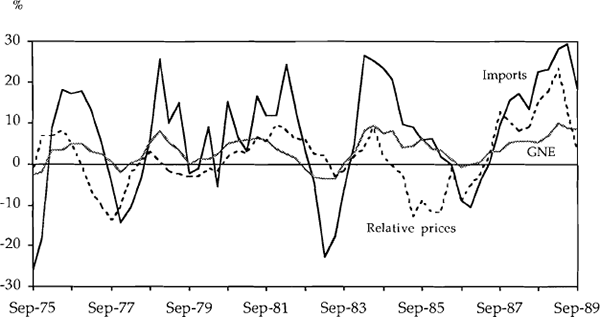RDP 8910: An Analysis of the Determinants of Imports 2. Trends in Endogenous Imports, Activity and Prices
December 1989
- Download the Paper 967KB
The two main influences on import growth are growth in domestic demand and changes in relative prices. Cyclical factors, such as the level of domestic capacity, also help to explain import growth particularly during periods when supply constraints are reached in the domestic economy.
Chart 1 shows growth in endogenous imports (that is, imports excluding “lumpy items” such as fuel, aircraft and defence equipment, which do not normally reflect the general level of demand), domestic demand, as measured by gross national expenditure and relative prices (represented by the price of domestically produced goods relative to the price of endogenous imports). It can be seen from the chart that as growth in demand increases, growth in imports typically picks up more than proportionately. Imports also respond positively to an increase in the price of domestic goods relative to the price of imports. An interesting point to note from the chart is that movements in domestic activity and relative prices have tended to reinforce each other. Of course when the domestic economy is running more strongly than overseas economies, there will be inflationary pressures on domestic prices relative to import prices. In addition, at these times, monetary policy tends to be tightened to reduce domestic inflation. This, in turn, tends to push up the exchange rate, further increasing the price of domestically produced goods relative to the price of imports.
ENDOGENOUS IMPORTS, DEMAND AND RELATIVE PRICES

Over the period shown on the chart, there were a number of cycles in imports. After falling through 1975 imports increased sharply in 1976 largely reflecting increasing domestic demand. However, the rise was not sustained and imports fell through 1977 and 1978, reflecting favourable movements in relative prices together with some slowing in demand. Throughout the remainder of the 1970s, imports continued to grow (although there were some small falls at the end of 1979) despite the fact that import prices were increasing faster than domestic prices.
In the 1980s, there were two complete cycles in imports. One began in the early 1980s, when there was a surge in imports associated with the ‘resources boom’. This was followed by a substantial fall in imports during the recession of 1982/83. Imports again grew very strongly in 1983 and 1984, reflecting the cyclical upswing of the economy, and slowed in 1985 and 1986 as domestic demand weakened and the exchange rate fell. However, the slowing in imports during this period was not as great as could have been expected given the extent of the fall in the exchange rate.
In the current cycle there has again been a strong rise in imports. Movements in domestic demand and relative prices have both acted to increase imports. Given the rapid rise in domestic demand, especially during late 1988 and early 1989, a general inability of supply to meet demand may also be an important factor in the recent growth of imports.
In fact, the increase in imports during the current cycle has been sharper and more sustained than in either of the previous two cycles. Most forecasters under-predicted this surge in imports. Some of this widespread under-prediction has recently been explained by special factors which underly the phenomenal growth in imports of motor vehicles (capacity constraints) and computers and other office machines (large falls in prices). These special factors would not be picked up by an aggregate demand-determined import volume equation.
While there is clearly cyclical behaviour in imports, it is also the case that the share of imports in total spending has shown a marked upward trend over time. Chart 2 shows the ratio of endogenous imports to non-farm sales. The increase has been particularly sharp at times of deteriorating competitiveness (for example, the early 1970s, the early 1980s and the late 1980s). One common explanation for the trend increase in the import penetration ratio is the decline in the Australian manufacturing sector, reducing the capacity for obtaining goods domestically. A trend increase in the import ratio would also be expected, however, given the worldwide trend toward increased specialisation and lower transportation costs.
ENDOGENOUS IMPORT PENETRATION RATIO
